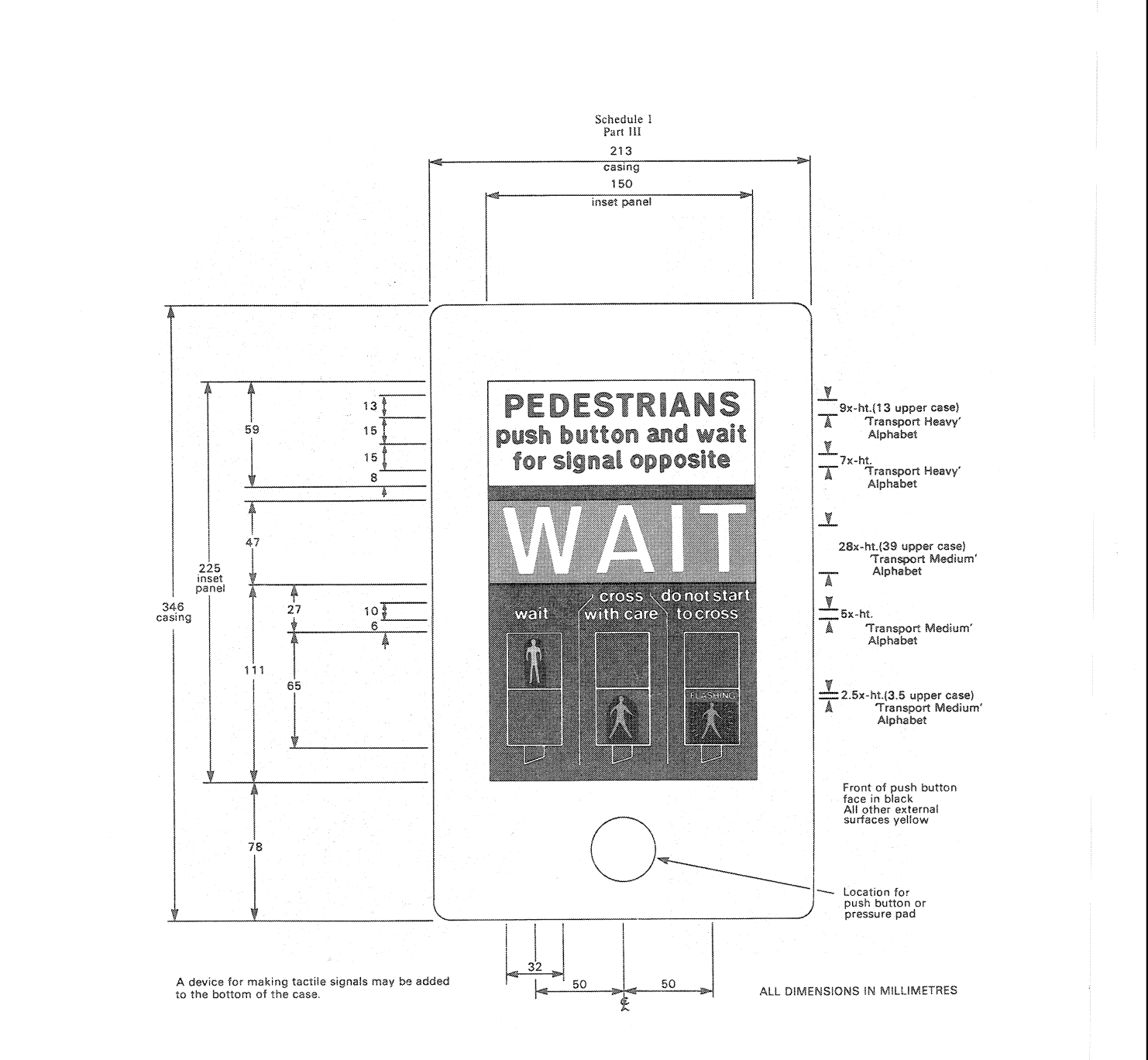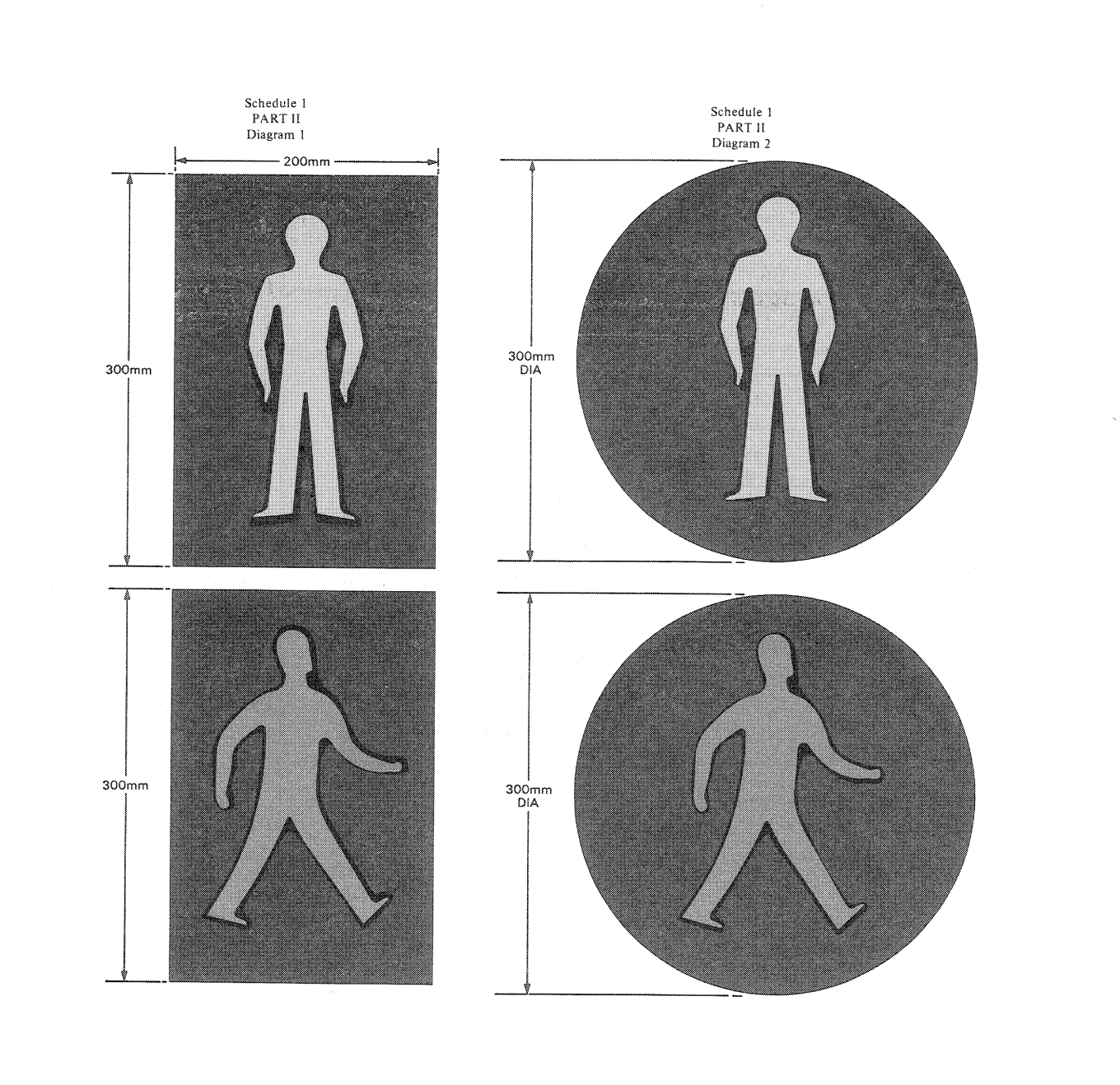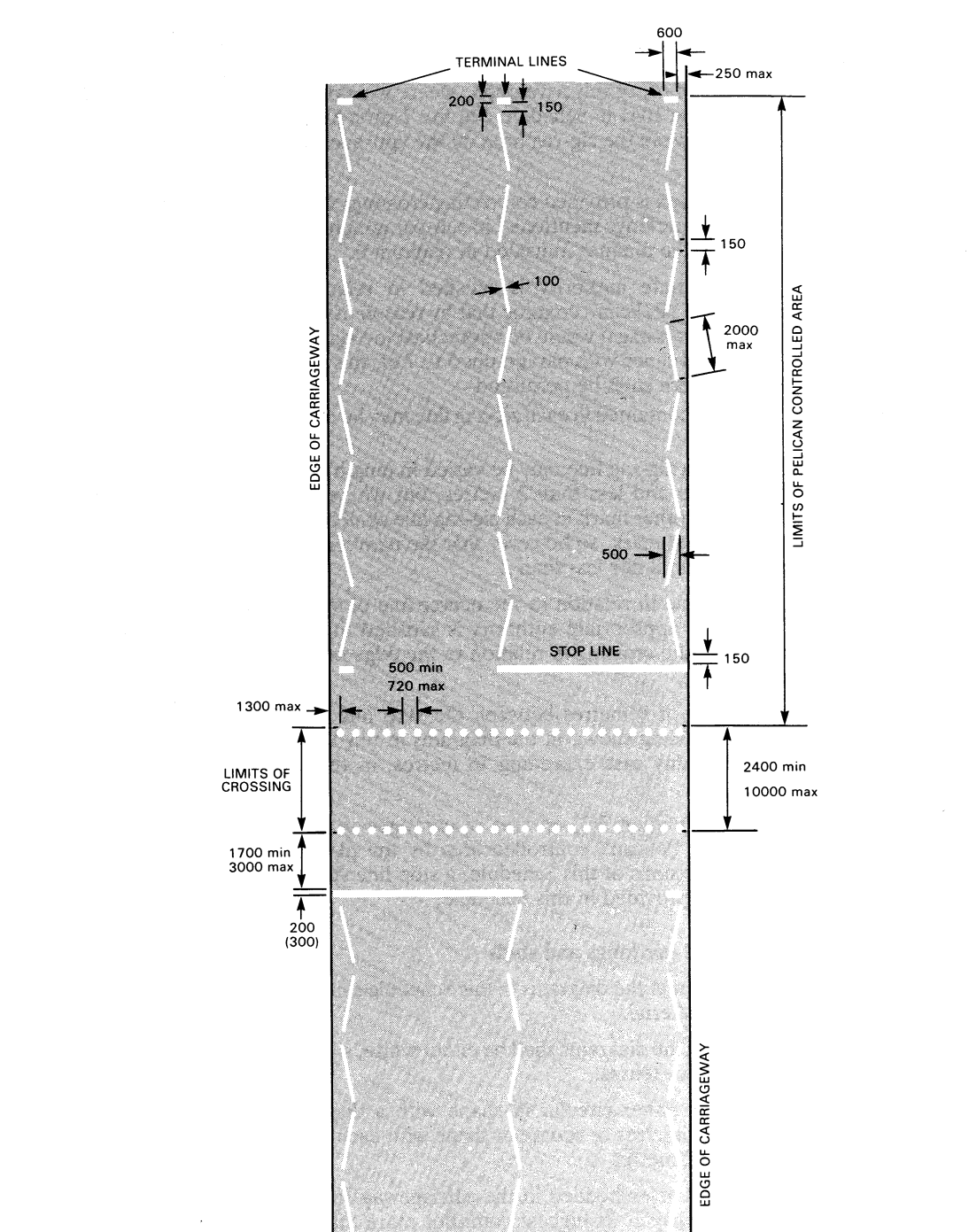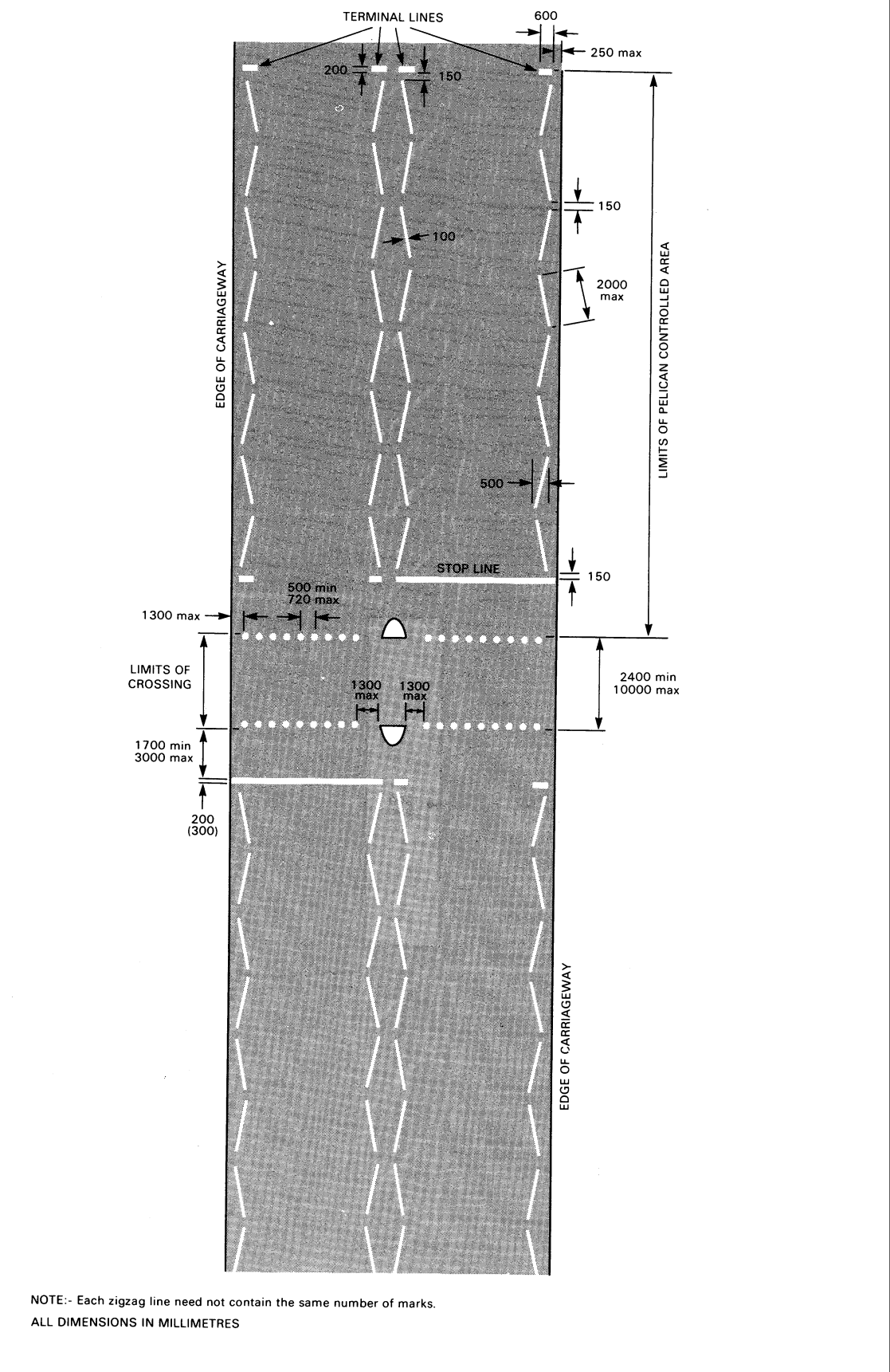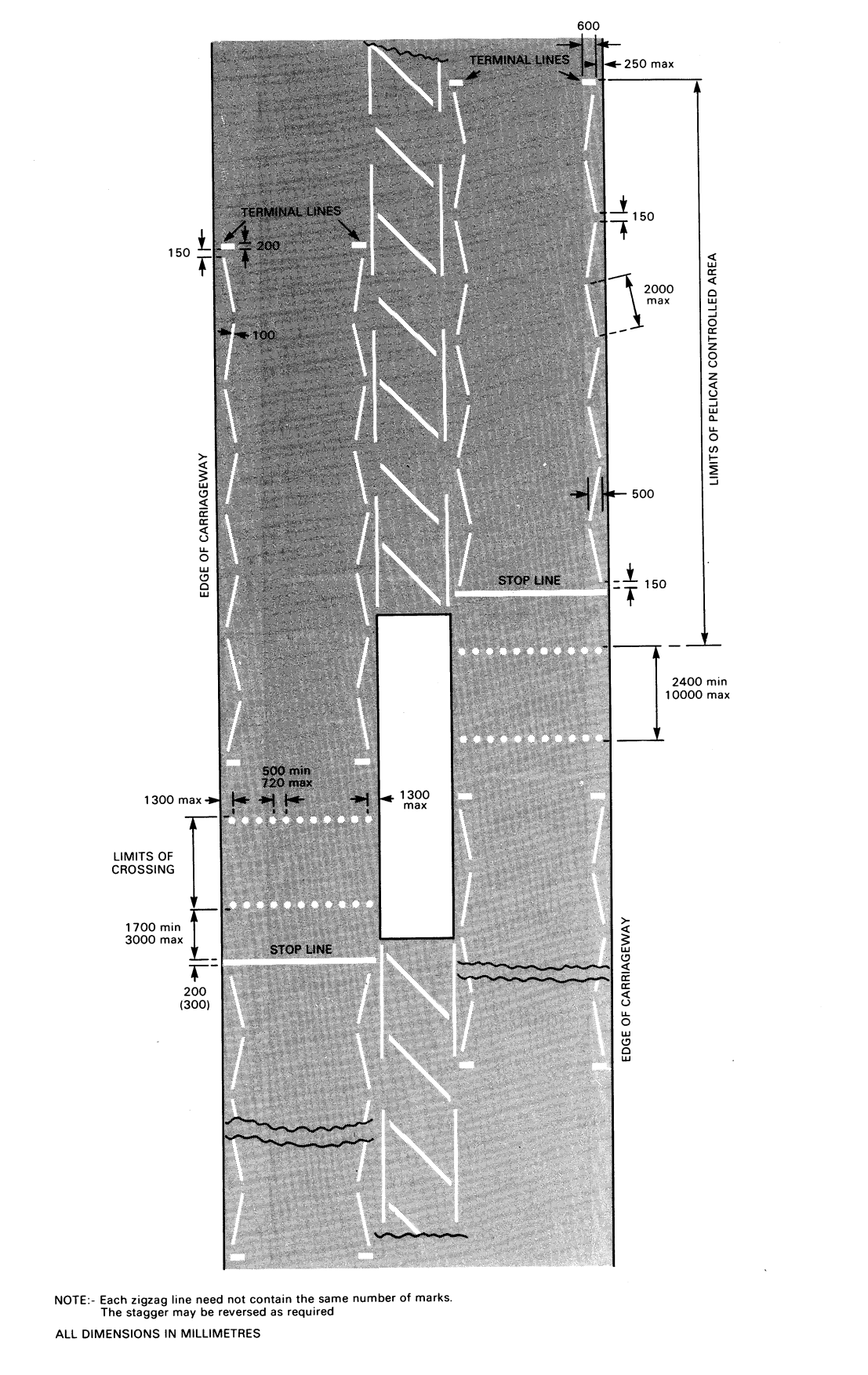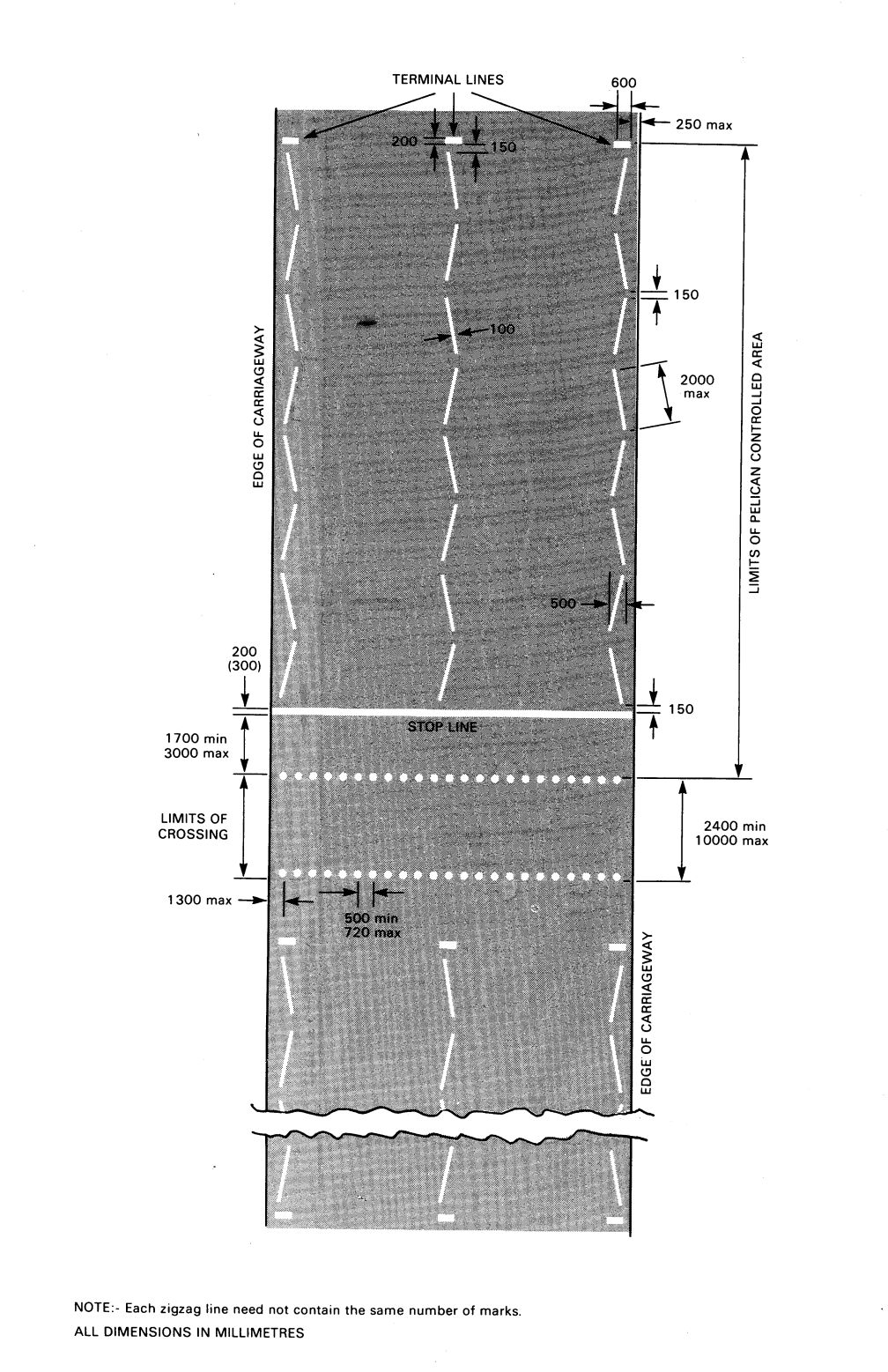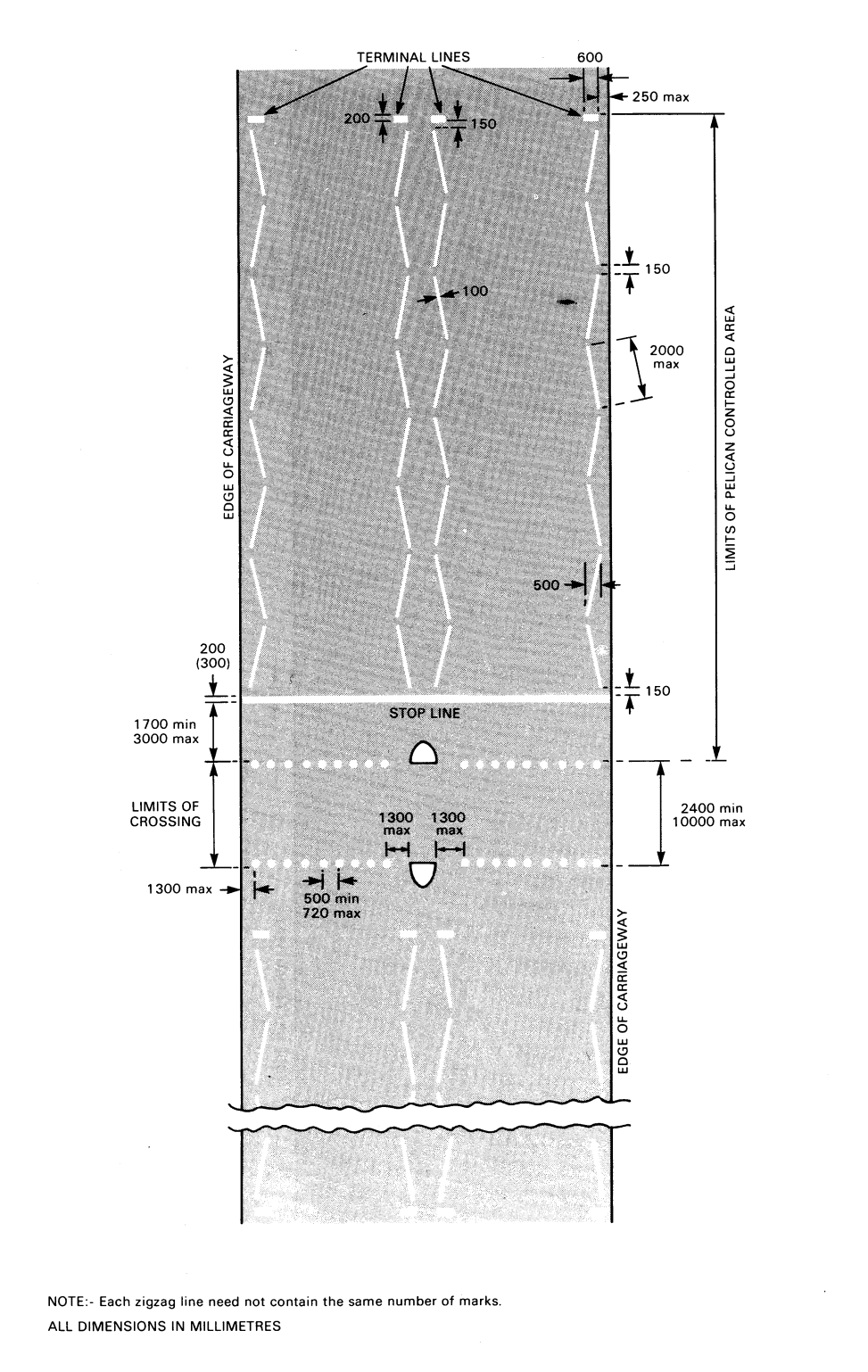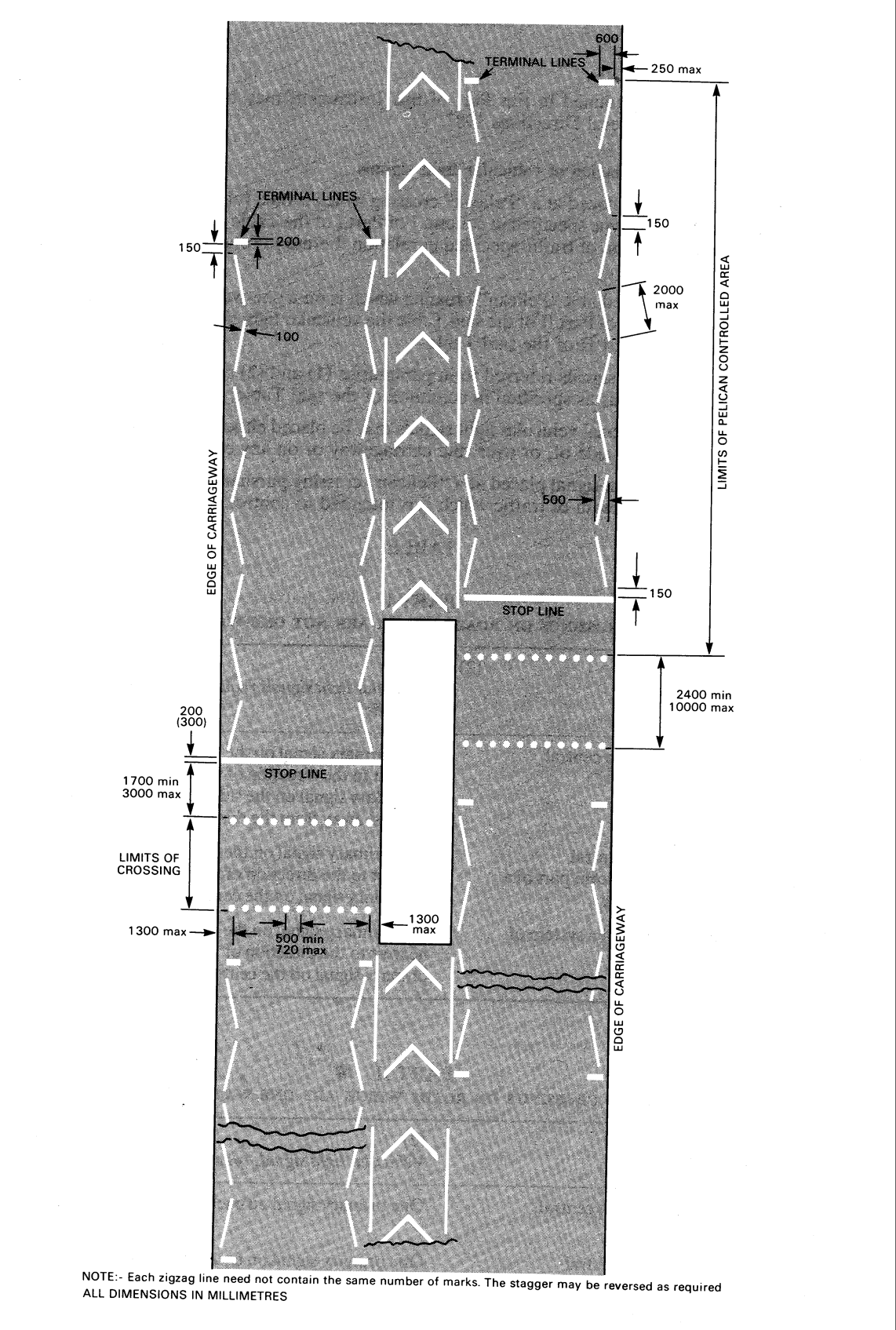Regulation 2(1)
SCHEDULE 1THE SIZE, COLOUR AND TYPE OF TRAFFIC SIGNS AT A “PELICAN” CROSSING
PART I
Traffic signs
1. The traffic signs which are to be placed at or near a crossing for the purpose of constituting it a “Pelican” crossing shall consist of a combination of–
(a)vehicular light signals;
(b)pedestrian light signals; and
(c)indicators for pedestrians,
of the size, colour and type prescribed by the following provisions of this Schedule, together with any additional traffic signs placed at or near the crossing pursuant to regulation 6.
Vehicular light signals
2. The vehicular light signals shall be as follows–
(a)three lights shall be used, one red, one amber, and one green;
(b)the lamps showing the aforesaid lights shall be arranged vertically, the lamp showing the red light being the uppermost and that showing the green light the lowermost;
(c)each lamp shall be separately illuminated and the effective diameter of the lens thereof shall be not less than 195 millimetres nor more than 220 millimetres;
(d)the height of the centre of the amber lens from the surface of the carriageway in the immediate vicinity shall, in the case of signals placed at the side of the carriageway or on a central reservation, be not less than 2.4 metres nor more than 4 metres and, in the case of signals placed elsewhere and over the carriageway, not less than 6.1 metres nor more than 9 metres;
(e)the centres of the lenses of adjacent lamps shall be not less than 305 millimetres nor more than 360 millimetres apart;
(f)the lamp showing the amber light shall be capable of showing a steady light or a flashing light such that it flashes at a rate of not less than 70 nor more than 90 flashes per minute; and
(g)no lettering or symbols shall be used upon the lens.
Pedestrian light signals
3.—(1) The pedestrian light signals shall be of the size, colour and type shown in the diagrams in Part II of this Schedule.
(2) The height of the lower edge of the container enclosing the light signals from the surface of the carriageway in the immediate vicinity shall be not less than 2.1 metres nor more than 2.6 metres.
(3) The said signals shall be so designed that–
(a)the red figure shown in the said diagrams can be internally illuminated by a steady light;
(b)the green figure shown in the said diagrams can be internally illuminated by a steady light or by a flashing light at a rate of not less than 70 nor more than 90 flashes per minute; and
(c)when one signal is illuminated the other signal is not illuminated.
(4) A device for emitting audible signals may be provided for use when the green figure is illuminated by a steady light.
Indicator for pedestrians
4.—(1) The indicator for pedestrians shall be of the size, colour and type shown in the diagram in Part III of this Schedule.
(2) The indicator for pedestrians shall be so designed and constructed that “WAIT” as shown on the diagram can be illuminated and that there is incorporated in the indicator a device, which may be a push button or pressure pad and which is hereinafter in this Schedule referred to as “a push button”, which can be used by pedestrians with the effect hereinafter described.
(3) The instruction for pedestrians shown in the diagram may be internally illuminated.
(4) A device for making tactile signals may be provided for use when the green figure shown in the diagram is illuminated by a steady light.
Sequence of signals
5.—(1) The vehicular light signals and pedestrian light signals and the indicators for pedestrians when they are placed at or near any crossing shall be so designed and constructed that–
(a)before the signals and indicators are operated by the pressing of a push button or as described in paragraph 6 of this Schedule the vehicular light signal shows a steady green light, the pedestrian light signal shows a red light, the word “WAIT” in the indicator for pedestrians is not illuminated, any device for making tactile signals is inactive, and any device for emitting audible signals is silent;
(b)when a push button is pressed–
(i)after the expiration of the vehicle period but before the vehicular light signals are showing a steady amber light, the signals and indicators, unless they are working as described in paragraph 6 of this Schedule, are caused to show lights in the sequences specified in descending order in column 1 in the case of vehicular light signals, in column 2 in the case of pedestrian light signals and in column 3 in the case of the indicators for pedestrians, of either Part IV or Part V of this Schedule;
(ii)when the vehicular light signals are showing a steady amber light or a red light when the signal to pedestrians shows a red or steady green light, there is no effect;
(iii)when the pedestrian light signals are showing a flashing green light, the word “WAIT” in each of the indicators for pedestrians is illuminated immediately and the signals and indicators are caused to show lights in the sequence specified in sub-paragraph (i) of this paragraph at the end of the next vehicle period; and
(iv)after the pedestrian light signals have ceased to show a flashing green light and before the end of the next vehicle period, the word “WAIT” in each of the indicators for pedestrians is illuminated immediately and the signals and indicators are caused to show lights in the sequence specified in sub-paragraph (i) of this paragraph at the end of the vehicle period;
(c)the periods during which lights are shown by the signals and the indicators, commence and terminate in relation to each other as shown in either Part IV or Part V of this Schedule as if each horizontal line therein represented one moment in time, subsequent moments occurring in descending order, but the distances between the horizontal lines do not represent the lengths of the periods during which the lights shown by the signals and the indicator are, or are not, lit.
(2) Where a device for emitting audible signals has been provided pursuant to paragraph 3(4) of this Schedule, it shall be so designed and constructed that a pulsed sound is emitted throughout every period when the pedestrian light signals are showing a steady green light, and at the same time the vehicular light signals are showing a red light, but only during such periods and at no other times, save that such a device need not operate during the hours of darkness.
(3) Where a device for making tactile signals has been provided pursuant to paragraph 4(4) of this Schedule, it shall be so designed and constructed that a regular movement perceptible to touch by pedestrians is made throughout every period when the pedestrian light signals are showing a steady green light, and at the same time the vehicular light signals are showing a red light, but only during such periods and at no other times.
(4) In this paragraph “vehicle period” means such period as may be fixed from time to time in relation to a “Pelican” crossing, which commences when the vehicular light signals cease to show a flashing amber light and during which the vehicular traffic light signals show a green light.
Operation by remote control
6. The vehicular light signals, pedestrian light signals, indicators for pedestrians, any device for making tactile signals, and any device for emitting audible signals, when they are placed at or near any crossing may also be so designed and constructed that they can by remote control be made to operate–
(a)as if a push button has been pressed; and
(b)so that the pressing of a push button has no effect, other than causing the word “WAIT” in each of the indicators for the pedestrians to be illuminated, until normal operation is resumed.
PART IVsequence of operation of vehicular and pedestrian light signals and indicator for pedestrians (but not the audible signals)
| Sequence of vehicular traffic light signals | Sequence of pedestrian signals | |
|---|---|---|
| Pedestrian light signals | Indicator for pedestrians | |
| (1) | (2) | (3) |
| Green light | Red light | The word “WAIT” is illuminated |
| Amber light | ||
| Red light | ||
| Green light | The word “WAIT” is not illuminated | |
| Flashing amber light | Flashing green light | The word “WAIT” is illuminated |
| Red light | ||
| Green light | ||
PART Valternative sequence of operation of vehicular and pedestrian light signals and indicator for pedestrians (but not the audible signals)
| Sequence of vehicular traffic light signals | Sequence of pedestrian signals | |
|---|---|---|
| Pedestrian light signals | Indicator for pedestrians | |
| (1) | (2) | (3) |
| Green light | Red light | The word “WAIT” is illuminated |
| Amber light | ||
| Red light | ||
| Green light | The word “WAIT” is not illuminated | |
| Flashing green light | The word “WAIT” is illuminated | |
| Flashing amber light | Flashing green light | The word “WAIT” is illuminated |
| Flashing amber light | Red light | |
| Green light | ||
Regulation 2(2)
SCHEDULE 2THE MANNER OF INDICATING THE PRESENCE AND LIMITS OF A “PELICAN” CROSSING AND “PELICAN” CONTROLLED AREA
General
1. In this Schedule, and except where otherwise stated, any reference to a numbered diagram is a reference to the diagram bearing that number in this Schedule.
2.—(1) Every crossing which is a “Pelican” crossing on a road which is not a one-way street shall have its limits indicated, subject to the following provisions of this Schedule, by the pattern of studs on or in and lines on the carriageway in the manner shown–
(a)in diagram 1 where there is no central reservation;
(b)in diagram 2 where there is a central reservation, but the crossing does not form part of a system of staggered crossings; and
(c)in diagram 3 where the crossing forms part of a system of staggered crossings.
(2) Every crossing which is a “Pelican” crossing on a road which is a one-way street shall have its limits indicated, subject to the following provisions of this Schedule, by the pattern of studs on or in and lines on the carriageway in the manner shown–
(a)in diagram 4 where there is no central reservation;
(b)in diagram 5 where there is a central reservation but the crossing does not form part of a system of staggered crossings; and
(c)in diagram 6 where the crossing forms part of a system of staggered crossings.
Manner of indicating the limits of the crossing
3. The limits of a “Pelican” crossing shall be indicated by two lines of studs in the positions shown, and in accordance with the measurements in, the diagram corresponding to the type of crossing.
4. The two lines of studs indicating the limits of the crossing need not be at right angles to the edge of the carriageway, but shall form straight lines and shall as near as is reasonably practicable be parallel to each other.
Manner of indicating a “Pelican” controlled area and provision as to placing the stop line
5. Subject to paragraph 8 of this Schedule, the presence and limits of a “Pelican” controlled area shall be indicated by the pattern of lines placed in the positions shown, and in accordance with the measurements, in the diagram corresponding to the type of crossing, and in accordance with the provisions of paragraphs 6 and 7 of this Schedule.
6. Where the crossing is on a road which is not a one-way street the pattern of lines shall consist of–
(1) a stop line placed on the carriageway parallel to the nearer row of studs indicating the limits of the crossing and extending, in the manner indicated in the appropriate diagram, across the part of the carriageway used by vehicles approaching the crossing from the side on which the stop line is placed;
(2) two or more longitudinal white broken lines (hereinafter referred to as “zig-zag lines”) placed on the carriageway or, where the road is a dual-carriageway road, on each part of the carriageway, each zig-zag line containing not less than 8 nor more than 18 marks and extending away from the crossing in the manner indicated in the appropriate diagram;
(3) subject to sub-paragraph (4) of this paragraph, where a central reservation is provided the road marking shown in diagram 1040.1 in Schedule 2 to the Traffic Signs Regulations 1981(1) may be placed on the carriageway between the zig-zag lines on the approaches to the central reservation;
(4) where a central reservation is provided connecting crossings which form part of a system of staggered crossings, the road markings mentioned in sub-paragraph (3) of this paragraph shall be placed on the carriageway in the manner indicated in diagram 3.
7. Where the crossing is on a road which is a one-way street the pattern of lines shall consist of:
(1) a stop line placed parallel to the nearer row of studs indicating the limits of the crossing and extending–
(a)in the case of a crossing of the type shown in diagram 4 or 5, from one edge of the carriageway to the other; and
(b)in the case of a crossing of the type shown in diagram 6, from the edge of the carriageway to the central reservation;
(2) two or more zig-zag lines placed on the carriageway, each containing not less than 8 and not more than 18 marks, and extending away from the crossing;
(3) subject to sub-paragraph (4) of this paragraph, where a central reservation is provided the road marking shown in diagram 1041 in Schedule 2 to the Traffic Signs Regulations 1981 may be placed on the carriageway between the zig-zag lines on the approaches to the central reservation; and
(4) where a central reservation is provided connecting crossings which form part of a system of staggered crossings, the road markings mentioned in sub-paragraph (3) of this paragraph shall be placed on the carriageway in the manner indicated in diagram 6.
8.—(1) Where the appropriate authority is satisfied in relation to a particular area of carriageway in the vicinity of a “Pelican” crossing that by reason of the layout of, or character of, the roads in the vicinity of the crossing it would be impracticable to lay the pattern of lines as shown in the diagrams in, and in accordance with paragraphs 5 to 7 of, this Schedule any of the following variations as respects the pattern shall be permitted–
(a)the number of marks contained in each zig-zag line may be reduced from 8 to not less than 2; and
(b)a mark contained in a zig-zag line may be varied in length so as to extend for a distance not less than 1 metre and less than 2 metres, but where such a variation is made as respects a mark each other mark in each zig-zag line shall be of the same or substantially the same length as that mark, so however that the number of marks in each zig-zag line shall not be more than 8 nor less than 2.
(2) The angle of the stop line in relation to the nearer line of studs indicating the limits of a crossing may be varied, if the appropriate authority is satisfied that such variation is necessary having regard to the angle of the crossing in relation to the edge of the carriageway at the place where the crossing is situated.
(3) The maximum distance of 3 metres between the stop line and the nearer line of studs indicating the limits of the crossing shown in the diagrams in this Schedule may be increased to such greater distance, not in any case exceeding 10 metres, as the appropriate authority may decide.
(4) Where by reason of regulation 3(3) an area of carriageway in the vicinity of a “Pelican” crossing is not constituted a “Pelican” controlled area by the placing of a pattern of lines as provided in the foregoing provisions of this Schedule, a stop line shall nevertheless be placed on the carriageway as previously provided in this Schedule.
Colour and dimensions of road markings and studs
9. The road markings shown in the diagrams in this Schedule shall be white in colour, and may be illuminated by reflecting material.
10.—(1) The studs shown in the diagrams shall be either white, silver or light grey in colour and shall not be fitted with reflective lenses.
(2) The said studs shall be either circular in shape with a diameter of not more than 110 millimetres or less than 95 millimetres or square in shape with each side being not more than 110 millimetres or less than 95 millimetres.
(3) Any stud which is fixed or embedded in the carriageway shall not project more than 18 millimetres above the carriageway at its highest point nor more than 6 millimetres at its edges.
11. Where in any diagram in this Schedule a dimension or measurement is indicated in brackets against a dimension or measurement not indicated in brackets any dimension or measurement indicated in brackets may be treated as an alternative to the dimension or measurement not so indicated.
Supplementary
12. The foregoing provisions of this Schedule shall be regarded as having been complied with in the case of any pattern of studs or white lines if most of the studs or lengths of white lines comply notwithstanding that one or more studs or some of the lengths of white lines may not comply with those provisions by reason of discoloration, temporary removal, displacement or for some other reason so long as the general appearance of the pattern of studs or white lines is not thereby materially impaired.
PART IIIgeneral directions
Citation
1. The Directions contained in this Part of this Instrument may be cited as the “Pelican” Pedestrian Crossings General Directions 1987.
Number and manner of placing of vehicular light signals
2.—(1) There shall be placed at a “Pelican” crossing which is on a road which is not a one-way street and which is of the type specified in column 1 of Part I of the Table below, the vehicular light signals facing each direction of traffic specified in relation thereto in column 2 of Part I of the said Table.
(2) There shall be placed at a “Pelican” crossing which is on a one-way street and which is of a type specified in column 1 of Part II of the said Table the vehicular light signals specified in relation thereto in column 2 of Part II of the said Table.
(3) The vehicular light signals referred to in paragraphs (1) and (2) shall be placed as primary signals or secondary signals as specified in column 2 of the said Table.
(4) One or more additional vehicular light signals may be placed either as a primary signal or as a secondary signal on the side of, or over, the carriageway or on any central reservation.
(5) Every vehicular light signal placed at a “Pelican” crossing pursuant to the provisions of this direction shall face the stream of traffic which it is intended to control.
TABLE
PART I
pelican crossings on roads which are not one-way streets
| (1) | (2) |
|---|---|
| Type of crossing | Vehicular light signals required facing each direction of traffic |
| Crossing on a road without a central reservation. | One primary signal on the side of the carriageway nearest to the direction of vehicular traffic and one secondary signal on the side of the carriageway furthest away from the direction of vehicular traffic. |
| Crossing on a road with a central reservation which does not form part of a system of staggered crossings. | One primary signal on the side of the carriageway nearest to the direction of vehicular traffic and one secondary signal on the central reservation. |
| Crossing which forms part of a system of staggered crossings. | One primary signal on the side of the carriageway nearest to the direction of vehicular traffic and one primary signal on the central reservation. |
PART II
pelican crossings on roads which are not one-way streets
| (1) | (2) |
|---|---|
| Type of crossing | Vehicular light signals required |
| Crossing on a road without a central reservation. | One primary signal on each side of the carriageway. |
| Crossing on a road with a central reservation which does not form part of a system of staggered crossings. | One primary signal on each side of the carriageway and one secondary signal on the central reservation. |
| Crossing which forms part of a system of staggered crossings. | One primary signal on the side of the carriageway and one primary signal on the central reservation. |
Number and manner of placing of pedestrian light signals and indicators for pedestrians
3.—(1) At least one pedestrian light signal and at least one indicator for pedestrians shall be placed at each end of a “Pelican” crossing.
(2) Where there is a central reservation in a crossing, one or more additional indicators for pedestrians shall be placed on the central reservation.
(3) Each pedestrian light signal at either end of the crossing shall be so placed as to be clearly visible to any person who is about to use the crossing at the other end of the crossing.
(4) Each indicator for pedestrians shall be so placed that the push button in the indicator is readily accessible to pedestrians who wish to press it.
Additional traffic signs
4. The traffic signs specified in diagrams 610 and 611 in Schedule 1 to the Traffic Signs Regulations 1981 shall be placed only on a central reservation in a crossing, or on a central reservation which lies between two crossings which form part of a system of staggered crossings.
Colouring of containers and posts
5.—(1) The containers of the vehicular light signals and of the pedestrian light signals shall be coloured black and may be mounted with a backing board and if so mounted the backing board shall be coloured black and may have a white border not less than 45 millimetres nor more than 55 millimetres in width which may be of a reflective material.
(2) Where a vehicular light signal, a pedestrian light signal or an indicator for pedestrians is mounted on a post specially provided for the purpose, that part of the post which extends above ground level shall be coloured grey and may have one white band not less than 140 millimetres nor more than 160 millimetres in depth, the lower edge of the band being not less than 1.5 metres nor more than 1.7 metres above the level of the surface of the ground in the immediate vicinity.
(3) Any box attached to a post or other structure on which pedestrian light signals or vehicular light signals are mounted and housing apparatus designed to control, or to monitor, or to control and monitor, the operation of such signals shall be coloured grey, yellow or black, or a combination of any of those colours.
Approval for mechanisms and sequence adjustments
6.—(1) Vehicular light signals, pedestrian light signals and indicators for pedestrians may be placed at or near any “Pelican” crossing only if the apparatus (including the content of all instructions stored in, or executable by, it) used to secure that the signals and indicators comply with the relevant provisions of the Regulations is of a type approved in writing by or on behalf of the Secretary of State.
(2) Such signals may be retained in place notwithstanding the subsequent withdrawal of any approval relating to any such apparatus.
Special Cases
7. Nothing in these Directions shall be taken to limit the power of the Secretary of State by any special direction to dispense with, add to or modify any of the requirements of the Directions in relation to any particular case.
Signed by authority of the Secretary of State.
Peter Bottomley
Parliamentary Under Secretary of State,
Department of Transport
7th January 1987
Malcolm Rifkind
Secretary of State for Scotland
12th January 1987
Nicholas Edwards
Secretary of State for Wales
12th January 1987
S.I. 1981/859, to which there are no relevant amending instruments.
